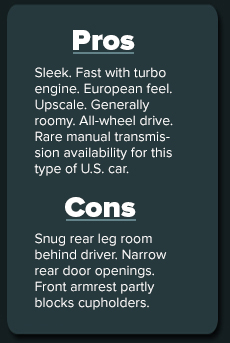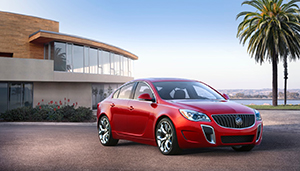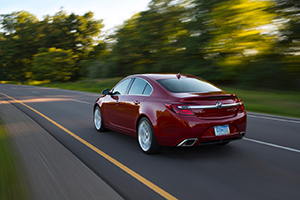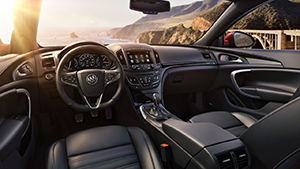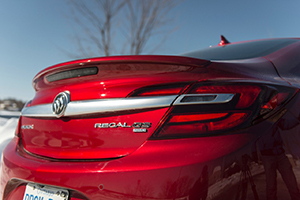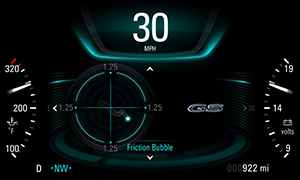2016 Buick Regal
The 2016 Regal skillfully
combines European and American sports sedan features.
Price: $27,065-$36,490
The 2016 Buick Regal has the look and feel of a solid European sports
sedan.
In fact, the Regal is an Americanized version of the upscale German
Opel Insignia. Opel is a General Motors subsidiary, and the Regal was
built in Germany before North American production began.
The high-performance turbocharged Regal GS, which I tested, is the most
desirable of the several Regal models and the one we will concentrate
on here.
Buick has built high-performance cars since the turn of the last
century. Its 1910 race car nicknamed the "Bug" was radically
streamlined for its time. The Bug had an enormous 622-cubic-inch
four-cylinder engine that let it hit 110 m.p.h. when regular cars
chugged along at about 30 m.p.h.
However, despite its upscale, rather soft image, Buick went on to
build the 1938 Century model with a 320-cubic-inch eight-cylinder that
made it one of the fastest cars of its day. The 1970 Buick GSX was one
of the best hard-charging, plushest muscle cars, and the 1987 Buick GNX
could out-accelerate a Chevrolet Corvette.
The various Regal models come with either front-drive (FWD) or
all-wheel-drive (AWD). Prices range from $27,065 to $36,490. The
top-line turbocharged Regal AWD GS has the largest list price.
New for 2016 Regals is an enhanced 8-inch color touch screen radio that
allows phone integration technology with applications such as
navigation, hands-free text messaging, contact lists and entertainment
apps for news and music.
Engines are a 2.4-liter four-cylinder with 182 horsepower, a 2.4-liter
"four"with the same power, but "light electrification technology" lets
a Regal get an estimated 36 mpg on highways and is for fleet customers.
Then there's the turbocharged 2-liter four-cylinder with 259 horsepower
and 295 pound/feet of torque.
Estimated GS Turbo fuel economy is 21 miles per gallon city and 30
highway with FWD and 19 and 27 with AWD. Premium fuel is recommended
for the turbo engine.
The AWD system is offered only for the turbo Regal GS. Its smooth,
quiet engine provides fast acceleration under city and highway driving.
My test car's Selective Ride Control had standard, sport or GS driving
modes. Standard was fine for most driving. sport mode stiffens the
shock absorbers for sharper handling, although I couldn't tell much
difference between normal and sport modes.
However, the GS mode provided more responsive handling with stiffer
shock absorbers for better body control. Also, the powertrain reacted a
bit more quickly to the accelerator pedal, and power steering
assistance was reduced.
But GS mode is overkill for normal street driving, and the Regal Turbo
AWD GS handled sweeping on-off freeway ramp curves well in just
standard mode, thanks partly to the AWD system. On the other hand, the
FWD Regal GS doesn't feel as heavy because it weighs less.
No matter mode, the fast steering in my test car didn't feel as firm as
I expected. A Buick spokesman noted when I mentioned this that the test
car's steering feel probably was caused by its variable-assist electric
steering, a different rear independent suspension design than that of
FWD GS and optional 20-inch (up from 19-inch) wheels.
The GS Turbo's ride was on the firm side no matter what the driving
mode, but was comfortable--thanks partly to an all-independent
suspension. A FWD GS might offer a slightly smoother ride.
Strong brakes worked well with linear, firm brake pedal action. The car
stopped quickly with no swerving with its anti-lock brakes, helped by a
Brake Assist feature.
Gauges could be quickly read in the quiet, upscale interior, and
controls were easy to use.
A high resolution 4.2-inch color display is the focal point of the GS
instrument cluster, providing such things as vehicle information,
navigation, audio system functions and phone features.
In the Regal GS, a standard 8-inch configurable color instrument
cluster screen lets a driver customize the displayed information with
adjustments via steering wheel controls. This instrument display
delivers chronograph-style graphics in two modes: Touring and Sport.
It's complemented with a pair of semicircle mechanical instruments for
the tachometer and other vehicle functions.
My test car's front seats provided exceptionally good support. Even the
rear seat was unusually well shaped for two occupants. The backseat on
many cars feels somewhat like a padded park bench.
However, the center of the backseat was stiff and best left to the wide
pull-down armrest, which contains twin cupholders and a shallow storage
compartment. Front cupholders are partly blocked by the center armrest.
There's decent room for two tall adults in the backseat, although
legroom is snug for a long-legged 6-footer behind a tall driver. All
doors open wide, but rear doors have rather narrow openings.
One convenient feature, found on top-end luxury cars, is a 110/120-volt
power outlet on the rear of the center console. It can be used to plug
in electrical equipment with a limit of 150 watts.
The trunk is roomy, and the rear seatbacks fold forward to greatly
enlarge the cargo area.
Transmissions are a responsive six-speed automatic with an easily used
manual shift feature or a six-speed manual. Being the turbo version, my
test GS had the automatic.
A six-speed manual transmission is unusual for a fairly large sporty
luxury U.S. car in America, but this transmission can only be had with
the FWD GS. A Buick spokesman said few GS models are ordered with the
manual, but that Buick felt it should offer it in the U.S. in keeping
with the car's sporty image.
Regals are nicely equipped with upscale interiors and lots of
comfort, convenience and safety features. They include
leather-appointed seating, numerous air bags, electronic stability
control, traction control, dual-zone automatic climate control, heated
front seats and a rear-vision camera system.
My test Regal AWD Turbo had a worthwhile $1,040 Driver Confidence
Package with items including a forward collision alert, rear
cross-traffic alert, lane departure warning, side blind zone alert with
lane departure alert and a following distance sensor.
A power moonroof added $1,000, and 20-inch aluminum wheels were $700.
The Regal is smoothly styled, but the turbocharged GS looks especially
racy with unique front and rear fascias, exclusive 19-inch wheels
(20-inchers are available), lowered ride height and nicely integrated
rear spoiler.
The front fascia incorporates prominent, vertical air intake slots, and
the rear fascia has a pair of integrated, satin-metallic trapezoidal
exhaust outlets that enhance the car's racy, upscale look. Rocker panel
extensions are part of the package. On each side of the hood are
Buick's simulated "ventiport" air inlets. The restyled, sleek
1949 Buick set a Buick trend with the automaker's now-legendary small,
nonfunctional round "portholes" in its front fenders.
Buick says the median age of its buyers is dropping, thanks partly to
its performance models. However, it adds that most Buicks are sold for
such things as their luxury, styling and high-quality ratings.
The new, sleek Buick Cascada four-seat convertible, which I've driven
and found to be a nice top-down "cruiser, should help sales and enhance
Buick's image. And guess what? It's also partly based on an Opel.

